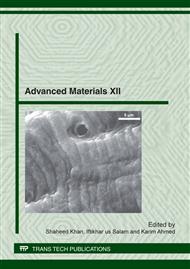p.540
p.547
p.554
p.560
p.569
p.577
p.585
p.591
p.597
Comparative Performance of Locally Made and the Foreign Made Dynamic Compression Plates
Abstract:
Bone implants are widely used to treat patients due to trauma in different causalities. The major types of bone implants are plates known as Dynamic Compression Plates (DCP) and nails, both made of stainless steel (AISI 316L Grade). In Pakistan both local made and foreign made (DCP) are available. The unit price of foreign made DCP is about 8 to 10 times that of the local made, however, no comprehensive study has been done on the comparison of these plates. An in-depth analysis was performed to compare the essential properties of six different brands of DCP including two foreign, two local and two unknown brands. These properties included mechanical properties, such as bending stiffness, yield strength, modulus of elasticity and hardness. Compositional analysis and various dimensions of plate important for bone healing process were also compared. The results show that all plates have similar mechanical properties. The compositional analysis showed some variations from the ASTM standards for most of the plates. The dimensional analysis of plates showed that Slot Width and Land were within range for most of the plates but the Spherical Radius was out of range for all the plates. Generally, all plates have no major differences in their properties, material and shape.
Info:
Periodical:
Pages:
569-576
Citation:
Online since:
May 2012
Authors:
Price:
Сopyright:
© 2012 Trans Tech Publications Ltd. All Rights Reserved
Share:
Citation:


